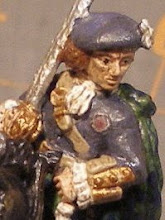I chose a scenario to replicate, as best as I could, the Prussian IV Korps attack into Napoleon's right flank at Waterloo and the resulting fighting over the town of Plancenoit. At first I was going to use our standard Napoleonic rules The Sound of the Guns by Larry Brom. But after some thought I realized that using them would entail too many units for a convention game. Luckily my good war gaming buddy Lord Sterling had recently bought a copy of Sam Mustafa's new rule set Blucher. After a couple of games under my belt, I decided that I would use that rule set, where the "brigade" is the basic maneuver unit.
After some research and re-reading of various books, mainly Peter Hofschroer's two volume 1815: The Waterloo Campaign, I arrived at my order of battle. The Anglo-Allied left flank would be represented by one British, two Hanoverian, and two Nassau infantry brigades and two British cavalry brigades, all controlled by one player. The attacking Prussians would consist of the entire IV Korps (controlled by two players) and the reinforcing lead elements of the I and II Korps (controlled by one player). The defending French would have Durutte's division, three cavalry divisions, and Lobau's VI Corps (all controlled by two players), with the Old and Young Guard reinforcements controlled by a third French player. This gave a strength of 40 Allied units versus 20 French units.
Now to some pictures of the action (photos by John M. and me):
 |
| The Prussian 15th Brigade (division) and its accompanying cavalry advance against the French. |
 |
| As French (left) and Prussian (right) cavalry charge and counter-charge in the foreground, John maneuvers his British cavalry so they can get into the action against Durutte's division. |
 |
| An overview of the battle taken from behind the Anglo-Allied positions at Haye and Papelotts. |
 |
| More swirling cavalry action in the center, but now the French massed horse artillery (right center) can get into action against the Prussian cavalry. |
 |
| With most of the French cavalry defeated, the left flank of the Prussian IV Korps marches forward towards Plancenoit (off picture to left). |
 |
| Durutte's French division (with four brigades) attacks the Anglo-Allied line at Haye and Papelotte. |
 |
| A higher angle shot of Durutte's assault. |
Although the French guard reinforcements were marching onto the battlefield the rest of the French army was pretty much shot. All of the cavalry and two of Durutte's brigades were destroyed. Lobau's VI Corps (five brigades) was still pretty much intact but it would soon be assaulted by nine Prussian infantry brigade-equivalents supported by five to six battery groups. Night was fast falling and the main French army was streaming away to the south, shouting "Sauve qui peut!!" at the top of their lungs. Thus the play test ended without any struggle over Plancenoit.
After some discussion, I resolved to have the Prussian IV Korps set up further in and bring the forward elements of the II Korps on at the beginning instead of waiting. I also will impress on the Prussian players that they must press their attack as swiftly as they can since the main Anglo-Allied army's position is in grave peril unless they can drive into the rear of the French army quickly.
And some observations on Blucher. It is a fairly easy rule set to learn to use, once the players get the movement sequence in their heads. But the finesse of figuring out when to move units and in what sequence will take more than just a game or two. The uncertain movement orders available to each side gives it a definite "fog of war" feel. Ranged artillery and infantry fire seemed to produce too few casualties but that may be a left over from our other Napoleonic rule set mentioned above. We will definitely play this rule set again, many times I feel.












1 comment:
Well done, nice looking game!
Post a Comment